Why is it that every time I meet someone new, and they find out that I am a
chef I am immediately asked, what kind of food do you make? I have never been
comfortable with this inquiry; I am aware the inference is what type of cuisine
do I make. I am a product of the society I grew up in, so I can only say, I
create American food. Not the foods that may have been laid out during the
Eisenhower administration – Jell-O molds have terrified since childhood.
Rather, I grew up experiencing a world’s worth of flavors and sensations within
the reach of my hometown. The “international aisle” of grocery store always
made me wonder, if all the other foods arranged on those shelves were American.
After culinary school where I kept my arm raised, and ears open to a myopic, intensive
Francophile’s discipline I set out the flesh out my education and satisfy a
long held nagging question…just what is American food and how did it evolve,
and what was this obsession with all things French?
The latter came a tad more easily for me too understand for the structured,
codified system of the French kitchen was capable of being replicated. There
was a centralized, static conversation coming out of the aristocratic class
that trained workers who subsequently found themselves unemployed with the
French revolution moving a rarified presentation to the cafes, bistros and
restaurants around the world. The same cannot be said of the more fragmented,
working-class based foods of the majority of the world. It has taken over 230
years and multiple waves of immigration and, the establishment of small
eateries throughout this land and the onslaught of television food shows to
give me an understanding of just what “American” food is. It is not just the
hotdog and water reconstituted mac-n-cheese but it is very spice, grain and
vegetable eaten across the globe and brought over to add comfort to an
otherwise unfamiliar life.
One’s comfort food for me has become a moment of marvel, exploration and
embrace – the true definition of authentic. The foundation I received in the
art of cooking has not changed; heat a pan first to prevent the item from
sticking and water boils at 212-degree Fahrenheit across the earth at sea level
goes with me everywhere. Though, I now think of everything as coming from the
international aisle, and only I, after 5 generations am American, and that is
highly debatable.
Layered Meat Pie – yields 9x3 inch spring form pan
 1-tablespooon smoked paparika
1-tablespooon smoked paparika
1-tablespoon coriander seed
1/8-teaspoon cinnamon
2-teaspoons annatto seed
4-cloves
1-teaspoon celery seed
1-teaspoon cumin
seed
¼-cup golden
raisins
1/3-cup chopped
sun-dried tomato
1-tablspoon chopped
fresh oregano leaves
2-teaspoon chopped
fresh thyme leaves
½-cup roughly
chopped green olives
1-tablespoon capers
1-large onion –
minced
5-cloves of garlic
- diced
½-pound ground chicken
½-pound ground pork
1-yellow plantain -
peeled and sliced on the angle into ½-inch pieces
 1-pound yucca – peeled
and center fiber discarded
1-pound yucca – peeled
and center fiber discarded
Salt and freshly
ground black pepper to taste
In a spice grinder
blend the paparika, coriander, cinnamon, annatto, clove, celery and cumin seeds
to a fine powder. Place in a large work bowl.
To the spice
mixture add the raisins, sun dried tomato, oregano, thyme, olives, capers,
onion, garlic, ground chicken and pork. Mix all together to thoroughly combine
all the ingredients.
Grate the yucca,
battata and yautia together, and season with salt and pepper.
Pre-heat the oven
to 350-degrees.
 Line the bottom
sides of the spring form pan with the sliced plantains to cover the outer
circumference. Press in a third of the grated yucca mixture with the ring of
the plantains. Then press in half of the meat mixture, then another third of
the yucca mixture. Repeat with the remaining meat mixture and yucca mixture.
Line the bottom
sides of the spring form pan with the sliced plantains to cover the outer
circumference. Press in a third of the grated yucca mixture with the ring of
the plantains. Then press in half of the meat mixture, then another third of
the yucca mixture. Repeat with the remaining meat mixture and yucca mixture.
Place the spring
form pan on a baking tray, cook in the oven for 2 hours. Remove from the oven
and allow the meat pie rest for a half hour to an hour before releasing the
spring form pan.
 Heat an eight to ten quart casserole pot over a high flame, and brown the short ribs on all sides. Once the ribs have browned add in the sliced onions, and cook until the onions just start to wilt. Then mix in the garlic, carrots, parsnips, mushroom (including dried), celery root, parsley, thyme and sage. Season with salt and pepper, and pour in 4-cups of water.
Heat an eight to ten quart casserole pot over a high flame, and brown the short ribs on all sides. Once the ribs have browned add in the sliced onions, and cook until the onions just start to wilt. Then mix in the garlic, carrots, parsnips, mushroom (including dried), celery root, parsley, thyme and sage. Season with salt and pepper, and pour in 4-cups of water. Bring to a boil and then reduce the temperature to medium-low and cover. Cook the stew for 2-hours. Then mix in the ¾-cups of barley, and return the lid, cooking for an additional hour. Correct the seasoning with salt and pepper.
Bring to a boil and then reduce the temperature to medium-low and cover. Cook the stew for 2-hours. Then mix in the ¾-cups of barley, and return the lid, cooking for an additional hour. Correct the seasoning with salt and pepper.

























